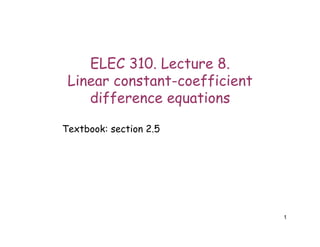
L8. LTI systems described via difference equations.pdf
- 1. 1 ELEC 310. Lecture 8. Linear constant-coefficient difference equations Textbook: section 2.5
- 2. 2 Ways to describe discrete LTI systems • 1) via the impulse response • 2) via difference equations – y[n]=some formula in x[n], and possibly x[n-n0], y[n-n0] • 3) via the frequency response • 4) via the transfer function (Z transform)
- 3. 3 Examples 1) Find the difference equation that characterizes the LTI system given by the following impulse response: h[n]=δ[n+1]-δ[n] 2) Difference equation representation for the accumulator system
- 4. Alexandra Branzan Albu ELEC 310-Spring 2008-Lecture 6 4 Description of LTi discrete systems via difference equations • This is an implicit specification of the system – Difference equations describe a relationship between the input and the output rather than an explicit expression for the system output as a function of its input - For finding this explicit expression, we must solve the differential equation - To find a solution, we need more information than provided by the differential equation alone - This information is specified by auxiliary conditions.
- 5. Alexandra Branzan Albu ELEC 310-Spring 2008-Lecture 6 5 General formula • A linear constant-coefficient difference equation of order N looks like: • All solutions y[n] can be expressed as a sum yh[n]+yp[n]
- 6. Alexandra Branzan Albu ELEC 310-Spring 2008-Lecture 6 6 Difference equation rewritten can be rewritten as: We need to know the input for all n as well as a set of N auxiliary conditions such as y[-N], y[-N+1], …, y[-1] in order to be able to solve the equation
- 7. Alexandra Branzan Albu ELEC 310-Spring 2008-Lecture 6 7 Condition of initial rest • We need auxiliary conditions to accompany the difference equation • Initial rest is the simplest and the most widely used auxiliary condition in LTI systems: An input x[n]=0 for n<n0 leads to an output y[n]=0 for n<no A causal input x[n]=0 for n<0 leads to a causal output y[n]=0 for n<0
- 8. Alexandra Branzan Albu ELEC 310-Spring 2008-Lecture 6 8 Special case: non-recursive equation If N=0, then Finite impulse response (FIR)
- 9. To summarize – A linear constant coefficient difference equation does not uniquely specify the system. The output for a given input is not uniquely specified. Auxiliary conditions are required – If auxiliary information is given as N sequential values of the output, we rearrange the difference equation as a recurrence equation and solve it for future and past values of the output. – If we know that the system is LTI and causal, then the system is fully specified by the LCCDE plus the condition of initial rest. 9
- 10. Example • 2.20 textbook Consider the difference equation representing a causal LTI system y[n] - (1/a)y[n-1]=x[n-1] a) Find the impulse response of the system b) For what ranges of a will the system be stable? 10